



How do we collectively care for Finsbury Park?
Which people and which creatures?
What part would you like to play?
We invite you to join us at Furtherfield to explore these questions. Together we will make and play a game with various characters, imagining Finsbury Park in 2025 as the place where a global multispecies revolution begins – and changes the world forever.
How can you get involved?
Originally planned for the Summer of 2020, the first community meetings took place in March, however Covid-19 has paused the development of this project. If you would like to work with the game designers Cade and Ruth, and each other, from Furtherfield Commons and online email Ruth at ruthcatlow [at] gmail.com.
About The Treaty of Finsbury Park 2025
At Summer Solstice a visiting delegation of artists, equipped with park blueprints, bylaws, data-sources, historical documents, and policies, will work with local envoys who present testimony from the many human and non-human lives of the park. Together, the two parties will work to mutually devise a treaty to govern the future actions of multispecies park users, turning the park itself into a “love machine”. This culminates in a public ceremonial treaty signing event.
With a bit of luck the game, final treaty, audio recordings, photographs, and resulting artistic responses are now planned for development and exhibition at Furtherfield in the Summer of 2021. Part role play game, part participatory performance, this event will be based at Furtherfield Commons and across Finsbury Park for three days at the Summer Solstice.
The Treaty of Finsbury Park 2025: On systems, ecologies as networks, colonialism and seizing rituals of power.
Read the essay
Hear the discussion between Ruth and Cade on the Furtherfield Podcast
Illustration by Sajan Rai.
If you have any questions or would like more information email Ruth at ruthcatlow [at] gmail.com.
This project is supported by CreaTures – Creative Practices for Transformational Futures. CreaTures project has received funding from the European Union’s Horizon 2020 research and innovation programme under grant agreement No 870759. The content presented represents the views of the authors, and the European Commission has no liability in respect of the content.
Ami Clarke, The Underlying at arebyte Gallery, London. 20 September – 16 November 2019.
When I enter the arebyte Gallery, I am immediately confronted with Ami Clarke’s Lag Lag Lag, a multi-screen installation displaying the structural model of BPA (Bisphenol A). This compound is a synthetic oestrogen which is a byproduct in plastic manufacturing processes. Its molecules have been recently found in water supplies around the world and are linked to hormonal imbalance. We are consuming molecules of plastic and are bodies are becoming such. BPA is beautifully modelled, a sculptural work in its own right, which is peacefully rotating on the screen. Underneath it, there is a looped script. I managed to grasp a sentence “Capitalism as a state of contingency becomes modus operandi.”
When Lag Lag Lag’s screen switches, it shows fluctuations in stock pice of the top 100 polluting companies in the world, the same big stakeholders who are responsible for over 70% of Earth’s pollutions. These statistics are accompanied by sentiment analysis of Tweets, also showing different datasets which are being analysed; emotional, joy, disgust, fear, sadness. Most often used in marketing for specific audience targeting, it indicates how our minute online actions can also be used to influence the already violent financial market.
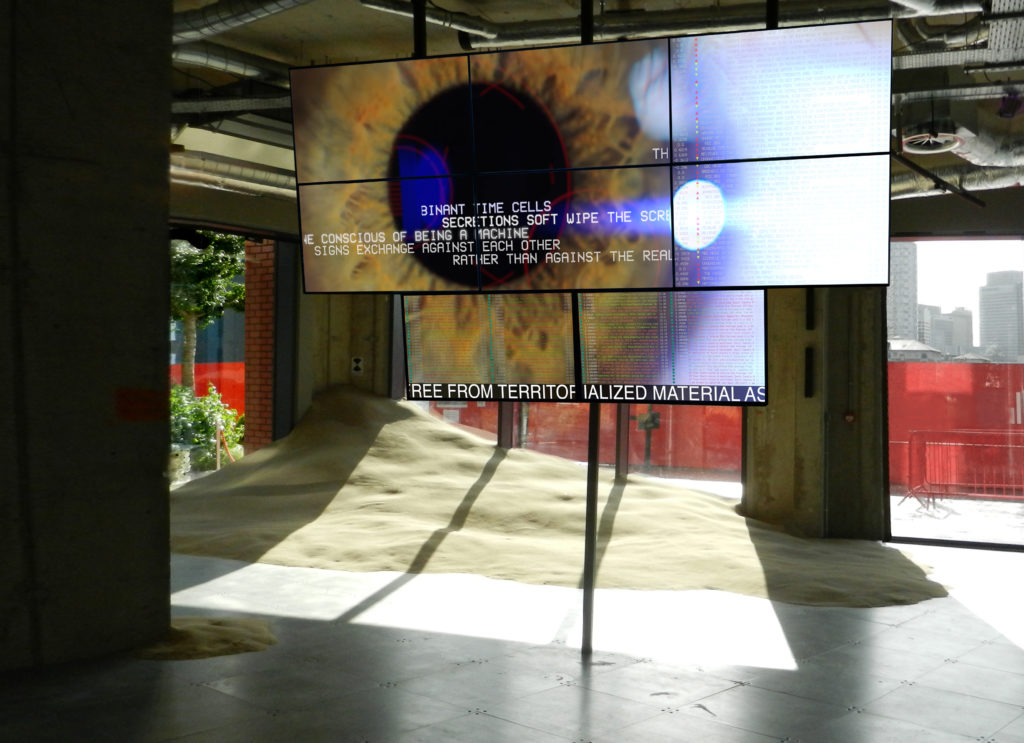
Clarke’s virtual reality work, Derivative, could as well be a digital trip to London in the aftermath of capitalism. Right after entering the experience, one can hear birds singing into the void and the wind carrying sand throughout the city maze. Its particles make up conical slopes in the corners between translucent buildings, which break up the surroundings into diamond-shaped fragments. I overcome them, slide a few inches above the ground by moving my thumb forward on the VR controller, which is increasingly making me lightheaded. The environment is blanketed with orange, eerie fog, reminiscent of the scenery from Blade Runner.
Further, the monotony of the landscape is interrupted by glimmering writing above the water surface. I set it as my destination, and move forward to it. The city is larger than it seems and it takes me a while to get close enough to read it. Still, I encounter no other living thing, only the lasers scanning through the buildings and my body, as if looking for sings of life. Eventually, I get to the end of the city, where I read the neon-green gothic script:
Welcome to the Offshore City
the city within the city
the tax haven
within the heart of Britain
Now I know what this place is and I dive further into the Offshore City, the tax haven for foreign investors, the headquarters for international companies, the slowly-beating heart of the world economy, supported by an invisible pump of the market. This time I am following a massive, burning sun and I encounter places modelled on London’s recognisable landmarks, such as Number 1 Poultry in Cheapside, an infamous suicide spot for depressed bankers, and, at the same time, one of the City’s oldest addresses, named “The Heart of the City”.
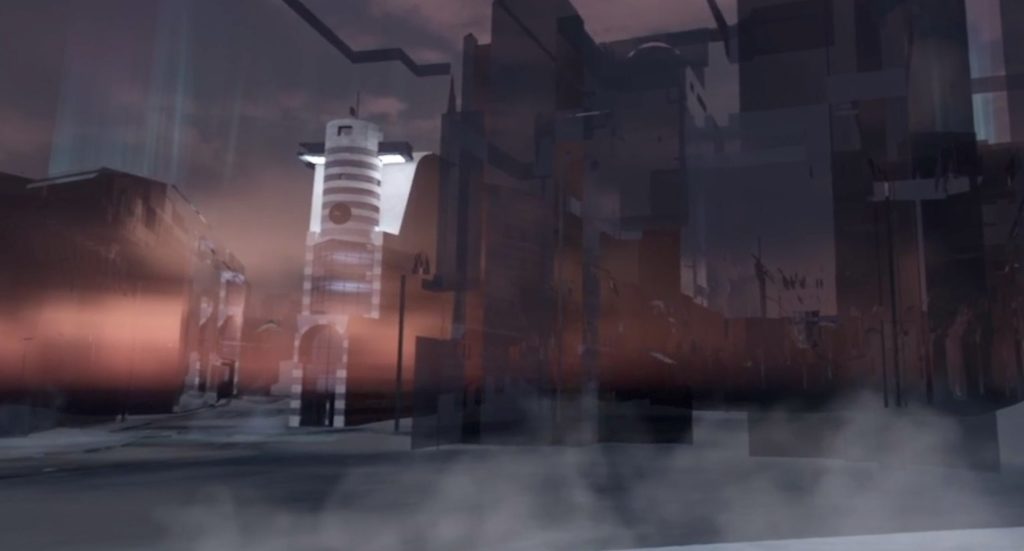
By using the lens of finance, Clarke points to both micro- and macro-scale of the environmental disaster and provides an unusual exploration of it. The accompanying rationalisation and monetisation feeds off the situation, and the capitalist system is shown as merciless and capable of using any opportunity to monetise on the dying planet. The lifeless scenery of Derivative directs attention to the inability of capitalist, finance-driven system to deal with its own creation in the light of planetary future.
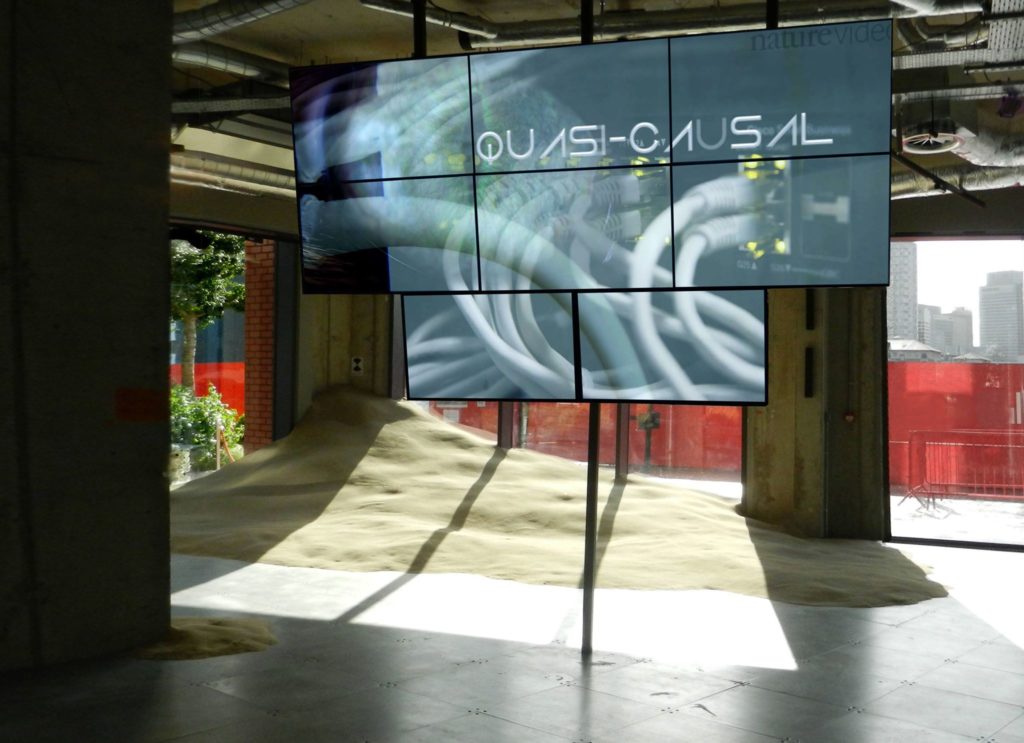
Only halfway through my time at arebyte, I realise that there are more pairs of eyes in the space than I thought. In three places in the exhibition space, there are installations made of prosthetic eyeballs, glued to the wall, their pupils fixated on various areas in the space. On the one hand, their synthetic, static gaze is reminiscent of the the all-seeing eyes of the CCTV cameras, on the other, they suggest disembodiment as in the sentiment analysis, whereby feelings are mechanically extracted and translated into data. Are we becoming cyborgs, or have we become them already?
The exhibition is a complex puzzle. It tackles difficult subjects, speculating in language, social media and economy. It is a powerful and slightly depressing, but intriguing picture. This dystopian vision of the future prompts questions; is it possible to re-imagine it? Can we come up with new narratives and stories and use speculation as a tool for revisioning the future? Where am I, as a viewer, positioned in the power relations imposed by the corporations and what freedoms do I have? At the time when the issues relating to the climate crisis are debated more than ever before, Ami Clarke’s The Underlying enters the conversation to problematise it through the exploration of technology, proposing a multilayered analysis of human and non-human agencies in the environmental catastrophe.
The above dystopian playlist was made in response to the exhibition. Recommended: listen while reading the review or on your way to the show.
The Underlying. Ami Clarke. Runs until Sat 16 Nov 2019.
https://www.arebyte.com/the-underlying
Algorithmic Food Justice is a research project that focuses on two injustices in the global food system and tests how emerging decentralised coordination technologies might support positive transformation.
It is a 6-month project led by researchers at City University, London in partnership with DECAL Decentralised Arts Lab at Furtherfield, Spitalfields City Farm and the Gaia Foundation. The project is funded by the Engineering and Physical Sciences Research Council “Not Equal Network”.
Firstly, unequal access to food. How can we create a sustainable “food commons”, where food production is managed for the benefit of all, including low income and ethnically diverse communities? Our project will explore this issue in partnership with urban agricultural communities, who already experiment with alternative models of labour and distribution within the fabric of our cities.
Secondly, we will address the injustices inflicted on other species by intensive human food production. To grow food successfully, humans require the help of other organisms – for example bees, or soil micro-organisms.
How might we use the features and affordances of blockchain technology to organise differently and to recognise and value the contributions of more-than-human participants, and therefore help avoid problems like soil degradation and bee extinction that threaten life on earth? How might this algorithmic “more-than-human value system” take shape in urban agricultural contexts?
This year, we will hold four workshops to collectively re-imagine a future food commons and operationalise different value systems by working with blockchain technologies. As we look into the future of urban farming, what will urban agricultural communities need in order to flourish, for the benefit of all? How can the interdependencies between humans, creatures and natural resources be better catered for?
Drawing on this collaborative and participatory work, we will develop speculative prototypes that float new arrangements of the food web and stimulate further discussion on how urban food futures might generatively reshape our increasingly algorithmic systems and environments.
http://algorithmicfoodjustice.net/
Featured image: Credit to Sara Heitlinger and Lara Houston
DOWNLOAD PRESS RELEASE (.pdf)
SEE IMAGES FROM ACCOMPANYING EVENTS
LISTEN to a recording of the conversation with John Conomos and Steven Ball at Furtherfield Gallery
Deep Water Web is a free exhibition at Furtherfield Gallery in London’s Finsbury Park, connecting opposite sides of the Earth to understand human impacts on the environment and the wider consequences for people living in both locations.
Artists Steven Ball (London, UK) and John Conomos (Sydney, Australia) have collaborated to present a multi-projection installation where London and Sydney are continuously connected across time zones. The exhibition is an immersive experience which the artists have termed a ‘hyperlandscape’ including real time streaming waterscapes and multiple local manifestations of global ecologies with their own sonic environments and narrated reflections.
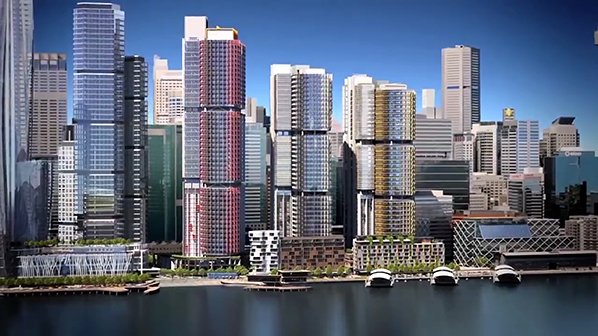
Deep Water Web is a poetic meditation around contemporary and historical geopolitical contexts, underscored by London and Sydney’s situation around large bodies of tidal water in the forms of the River Thames and Sydney Harbour. These bodies of water bear material evidence of the local impact of global warming, such as rising tide levels caused by melting ice caps, leading to flooding, and increasingly extreme climate fluctuation. Both cities are also centres of neoliberal capitalism, inscribing the effects of privatisation, fiscal austerity and deregulation of markets across the planet.
Deep Water Web weaves rhetorical explication of postcolonial relationship, elaborating the precarious material forms of climate change, and post-labour late capitalist neoliberal urban developments of waterfronts of former Docklands, considered within the geological and rhetorical ecology of the Anthropocene.
The age of global warming and global neoliberal capitalism are figured here as critical rhetorical realms. These phenomena can be described as what Timothy Morton has called hyperobjects, objects so massively distributed in time and space as to transcend localisation. While they are impossible to comprehend at scale, hyperobjects exert a profound effect at a local level.
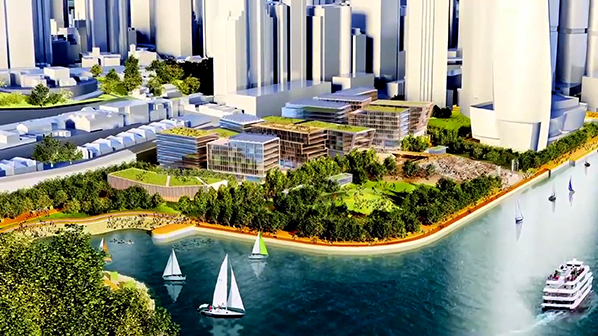
Deep Water Web will also become a catalyst for a workshops series at Furtherfield Commons, which will extend its themes through media based excavations. [dates and full details to be confirmed]
Both artists both have long standing moving image based practices and an interest in landscape and the representation of place. As a hyperlandscape this project suggests that questions of relationship to place, and the construction of landscape, can in the Anthropocene no longer be considered as simply pictorial representation or subjective experience, but is constituted from a range of critical, ethical, ecological, and political positions and concerns.
+ MORE INFO: http://deepwaterweb.net
Deep Water Web is supported by Arts Council England.
Exhibition Tour with artist Steven Ball
Tuesday 4 October 2016 – 5:30-6:15pm – Furtherfield Gallery
Revolutions and Complex Systems
Every Tuesday for 6 weeks
6:30 – 8:30pm at Furtherfield Commons – from 27 September 2016
BOOKING ESSENTIAL
A conversation with John Conomos and Steven Ball
2-3pm Saturday 29 October – Furtherfield Gallery
Booking is essential for this free event
Furtherfield in partnership with the antiuniversity and Radical Think Tank are proud to present this new 6-part course led by Graham Jones.
Aimed at people with an interest in social change, the course will apply concepts from complex systems theory to understanding revolutions and social movements. Sessions will involves a mix of speaker presentation and participatory discussions/activities, covering subjects such as ecology, network theory and new materialist philosophy.
Graham Jones is an activist based in East London, working with groups such as Radical Assembly, Radical Housing Network and Radical Think Tank. Booking Essential.

Steven Ball is an artist, writer and academic based in London, working with audio-visual media engaged with landscape and spatial representation, in local and global, social, political and post-colonial spheres. Since 2003 he has been Research Fellow at Central Saint Martins and was instrumental in developing the British Artists’ Film and Video Study Collection.
John Conomos is an artist, critic and writer based in Sydney, Australia. His books, essays and artworks are framed within four traditions of contemporary art: Anglo-American and Australian cultural studies, critical theory and post-structuralism. He is a New Media Fellow of the Australia Council for the Arts, and Honorary Professor at Victorian College of the Arts, University of Melbourne.
Furtherfield was founded in 1997 by artists Marc Garrett and Ruth Catlow. Since then Furtherfield has created online and physical spaces and places for people to come together to address critical questions of art and technology on their own terms.
Furtherfield Gallery
McKenzie Pavilion
Finsbury Park, London, N4 2NQ
Visiting Information
Furtherfield Gallery is supported by Haringey Council and Arts Council England
The insights of American anarchist ecologist Murray Bookchin, into environmental crisis, hinge on a social conception of ecology that problematises the role of domination in culture. His ideas become increasingly relevant to those working with digital technologies in the post-industrial information age, as big business daily develops new tools and techniques to exploit our sociality across high-speed networks (digital and physical). According to Bookchin our fragile ecological state is bound up with a social pathology. Hierarchical systems and class relationships so thoroughly permeate contemporary human society that the idea of dominating the environment (in order to extract natural resources or to minimise disruption to our daily schedules of work and leisure) seems perfectly natural in spite of the catastrophic consequences for future life on earth (Bookchin 1991). Strategies for economic, technical and social innovation that fixate on establishing ever more efficient and productive systems of control and growth, deployed by fewer, more centralised agents have been shown conclusively to be both unjust and environmentally unsustainable (Jackson 2009). Humanity needs new strategies for social and material renewal and to develop more diverse and lively ecologies of ideas, occupations and values.
In critical media art culture, where artistic and technical cultures intersect, alternative perspectives are emerging in the context of the collapsing natural environment and financial markets; alternatives to those produced (on the one hand) by established ‘high’ art-world markets and institutions and (on the other) the network of ubiquitous user owned devices and corporate social media. The dominating effects of centralised systems are disturbed by more distributed, collaborative forms of creativity. Artists play within and across contemporary networks (digital, social and physical) disrupting business as usual and embedded habits and attitudes of techno-consumerism. Contemporary cultural infrastructures (institutional and technical), their systems and protocols are taken as the materials and context for artistic and social production in the form of critical play, investigation and manipulation.
This essay presents We Won’t Fly for Art, a media art project initiated by artists Marc Garrett and I in April 2009 in which we used online social networks to activate the rhetoric of Gustav Metzger’s earlier protest work Reduce Art Flights (from 2007) in order to reduce art-world-generated carbon emissions... Download full text (pdf- 88Kb) >
Published in PAYING ATTENTION: Towards a Critique of the Attention Economy
Special Issue of CULTURE MACHINE VOL 13 2012 by Patrick Crogan and Samuel Kinsley.